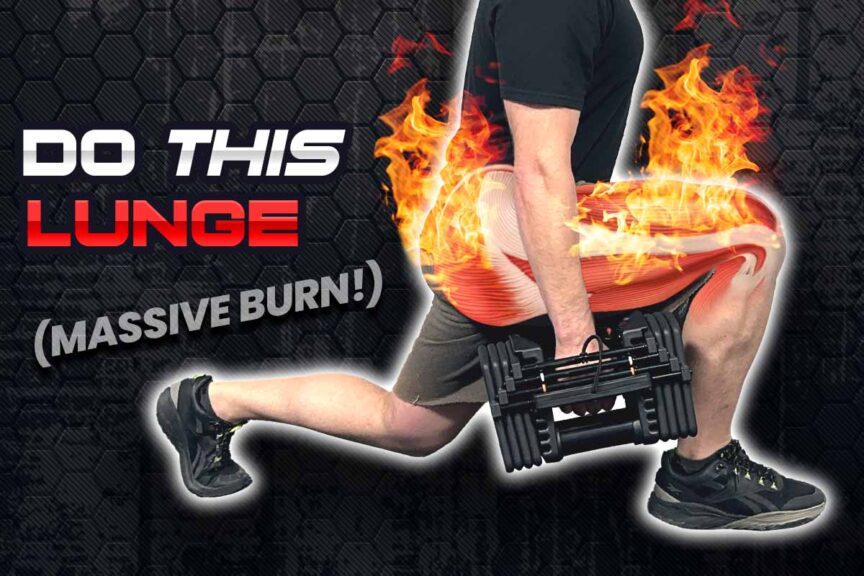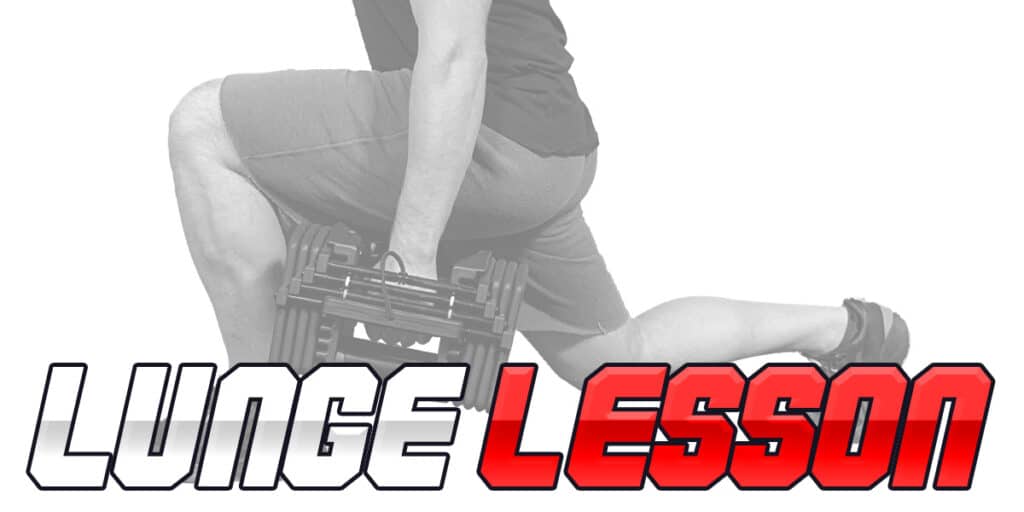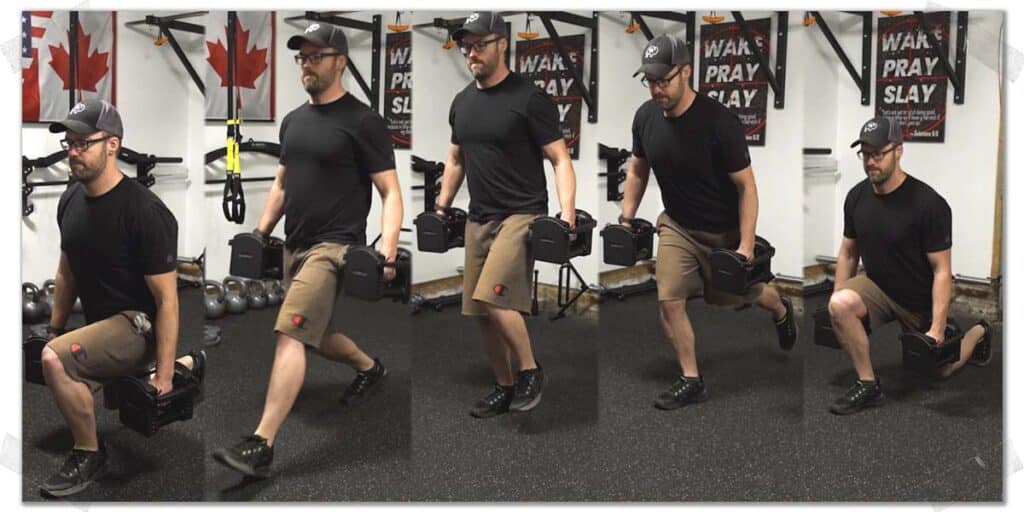If you want to get some seriously stronger legs without having to do a bunch of different exercises, this article is for you.
In this article, you’ll learn about a lunge variation that offers unique benefits not found in any other lunging exercise. It’s like a Swiss Army knife of lower body exercises, allowing you to target multiple muscles in your body, challenge your balance and even enhance something known as proprioception.
So, what type of lunge are we talking about here? It’s known as the forward-backward lunge, and (in my humble opinion) it’s not nearly as popular as it should be; a lot of active individuals and athletes are missing out.
If you opt to put it into your training routine, you’ll be getting a world of strength, endurance, and hypertrophy (muscle size increase). As a bonus, I’ll even throw in a quick bit on how it can prevent common injuries experienced by many active individuals.
So, let’s get to it.
Related Article: Bulgarian Split Squat Benefits (Are You Missing Out) | Make Gains!
Why: perform THIS specific lunge?
When it comes to lunges, there are multiple ways they can be performed, and every type of lunge has its time and place. But if there were only one lunge to do — one that rules them all — it would be the forward-backward lunge. It’s a lunge that is exactly what it sounds like, but don’t let its simplicity fool you here; it packs a massive punch. Keep reading to learn why.
Unlike a standard walking lunge or a standard stationary lunge (which, to be clear, are still outstanding exercises), the forward-backward lunge packs a wallop for challenging the muscular endurance of your lower body.
This is achieved through the continuous movement the exercise requires; there are no rest breaks between repetitions, which means your quadriceps muscles, gluteal muscles, and even your hamstrings will be required to do a large volume of work without any recovery occurring until the entire set is complete.
Related article: Lunges: When Your Knee Should & Shouldn’t Touch the Ground (Pro Tips)
This applies largely to your stance leg (which supports your body weight at all times) and, to a slightly lesser extent, your swinging leg, which will get a tiny break at points, but trust me, it’s not much!
So, let’s take a look at how to perform this lunge and what happens throughout each phase of the movement!
How to: performing the forward-backward lunge
As you drop forward into the lunge, you’ll eccentrically strengthen your quadriceps and glute max muscle as you would with any other type of lunge. However, to launch yourself back up to the starting position, you’ll need to give your quadriceps a hefty contraction to make this happen.
The challenge is only beginning at this point; as you return to the upright position, your goal is to keep your foot off the ground and immediately swing it backward so that you can drop into another lunge. And something really cool happens with this backward lunge process, which I’ll cover in just a moment.
Related Article: Nine Ways to Make Lunges WAY Harder Without Adding Any Weight
Once you’ve completed this second lunge, you explode out of this position using your hips and quads on your stationary leg. And you guessed it, you explode out of this position so that you can swing your leg through and drop into the forward lunge to repeat the process.
The beauty here is that you are training both legs at the same time! Your swinging leg gets a hefty challenge when dropping into and pushing out of the front lunge, and your stance leg gets a hefty challenge when rising out of the other lunge. It’s truly a two-for-one deal.
And then, of course, once you’ve completed all of your repetitions with your swinging leg, you get to repeat the process using your other leg!
Now, if need be, you can modify this lunge and make it a bit easier by placing your foot back down on the floor between each lunge, either to regain your balance or to take a small break. But keep in mind that your goal is to get to a point where you can complete all of your repetitions without ever having your foot touch down at the halfway point.
Pro tip: When you swing your leg backwards to drop into the lunge, do this in a very controlled manner. Don’t sink into the lunge until your foot is securely on the ground. Not only does this keep you safe by maintaining good form, but it also enhances your proprioception.
Proprioception is the fancy-sounding word that refers to our brain’s ability to feel and interpret the location of a body part in space without visual input. And since you can’t see where you’re placing your foot behind you when swinging your leg backwards, this controlled lunge helps your brain to improve proprioception for your foot, ankle, and knee.
Bonus: How this lunge optimizes lower back health
Now, let’s talk about how this lunge can actually help prevent lower back pain. Yes, you heard me right — a lower body exercise that keeps your lower back in a healthier state. Here’s how:
When you perform this lunge, the hip muscles in your stance leg are working non-stop, which you will certainly feel if you complete a bunch of repetitions without letting your swinging leg touch the ground at any point.
RELATED CONTENT:
These deep hip stabilizer muscles, notably the glute medius and minimus, among others, are therefore strengthened in the process. These hip stabilizer muscles are functionally intertwined with stability and muscular function within your lower back.
The goal here in this article isn’t to give you a detailed lecture on this relationship but merely to raise your awareness of the importance of ensuring these hip muscles are kept strong and healthy to keep your lower back healthy and pain-free.
Final thoughts
Now, if you think all of that was pretty cool, you’ll want to check out this article on the Bulgarian split squat, where I go over what makes this lower body exercise unlike any other. It’s a concise rundown that will serve to show you how and why this movement will help you build a set of seriously bulletproof legs.
So, I’ll see you over there. And in the meantime, keep making great things happen!

Hi! I’m Jim Wittstrom, PT, DPT, CSCS, Pn1.
I am a physical therapist who is passionate about all things pertaining to strength & conditioning, human movement, injury prevention and rehabilitation. I created StrengthResurgence.com in order to help others become stronger and healthier. I also love helping aspiring students and therapists fulfill their dreams of becoming successful in school and within their clinical PT practice. Thanks for checking out my site!



